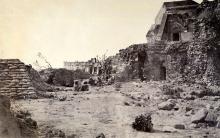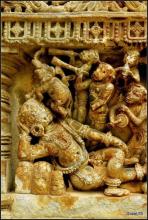Indrajit quickly understood Rāma’s strategy. The master of illusions placed before him an illusory Sītā and pretended to kill her before his enemies’ eyes. As an enraged Hanūmān rushed at him, he noticed Sītā in Indrajit’s chariot. She looked sorrowful and her face was pale because of fasting; the lady, Rāma’s beloved, wore but a single piece of garment which was unwashed and worn out. Hanūmān observed her for a moment and concluded that she was certainly Maithilī and shed tears.
Author:hari
पुराणों के लक्षणों को दर्शाने वाला प्रसिद्ध श्लोक जो पुराणों की पांच मुख्य विषयवस्तु का वर्णन करता हैः-
There was a rich man I knew. When all members of his household were asleep, he would enter his room with a small lantern, open his iron safe, noiselessly remove the bundles of currency notes and jewellery one by one from it, caress them fondly, count them again and again, exult at owning all of it, put all of it back again into the safe, lock it, and tie the key to his yajñopavīta[1]. He experienced happiness in looking upon his wealth by himself.
ಟೀಕೆ, ಚಿಕಿತ್ಸೆ
ಈ ಒಂದು ಅಂಶವೇ ಮತ್ತೊಂದು ಪ್ರತ್ಯೇಕ ಅಧ್ಯಾಯವನ್ನು ಬಿಚ್ಚಿಡುತ್ತದೆ, ಅದೇ ಒಂದು ವಿಶಿಷ್ಟ ಅಧ್ಯಯನದ ವಸ್ತುವೂ ಹೌದು. ಅದೆಂದರೆ ಡಿ.ವಿ.ಜಿ. ಅವರು ದೇಶೀಯ ಸಂಸ್ಥಾನಗಳನ್ನು ಕುರಿತು ಐತಿಹಾಸಿಕ ಹಿನ್ನೆಲೆಯಿಟ್ಟುಕೊಂಡು ಮಾಡಿದ ಹೇರಳವಾದ ಟೀಕೆಗಳು. ಗುಂಡಪ್ಪನವರು ದೇಶೀಯ ಸಂಸ್ಥಾನಗಳ ಕುರುಡು ವಕ್ತಾರರಾಗಿರಲಿಲ್ಲ. ಆ ವಿಷಯವನ್ನು ಸಮಗ್ರ ದೃಷ್ಟಿಯಿಂದ ವೀಕ್ಷಿಸಿದ್ದರು, ಚಿಕಿತ್ಸಕವಾಗಿ ಮಂಡಿಸಿದ್ದರು.
Kumbhakarṇa took a massive form as he marched ahead. His eyes were as large as a cartwheel and he looked like a moving mountain. As he came to the battlefield, he said to his men, “I will burn the army of monkeys this very day. Well, but they have not caused me any harm and are in fact, ornaments for gardens and parks in our cities. However, they will be slaughtered because of Rāma and Lakṣmaṇa.” As he marched ahead dreadful omens appeared all around.
क्षात्र की भारतीय परम्परा में राजधर्म के दृष्टिकोण को समझने हेतु यंहा हमारे ग्रंथो से धर्म तथा अर्थ संबंधी कुछ उदाहरण प्रस्तुत हैं – अत्रिस्मृति तथा विष्णु धर्मोत्तर पुराण में निम्न पांच महायज्ञ राजा के कर्त्तव्य हैं –
दुष्टों को दण्ड़, सज्जनों का सम्मान,
न्यायोचित पथ से प्रगति और समृद्धि,
जन आकांक्षाओं और प्रश्नों का पूर्वाग्रह रहित न्यायोचित निर्णय,
भूमि संरक्षण[1]
There is a set of rules for the riders on the merry-go-round. The rider should proceed in his path and not collide with those ahead of him and those who follow him. Dharma is such a set of rules. If any of those rules is violated - say, the front rider does not leave way for the rider behind him or if a following rider drags the one ahead of him down - it is a sign that the rider has forgotten about the machine operator and that he has to be reminded of it. The behaviour of not troubling others is dharma. It is a kind of conduct.
We move on to the next work, Hāsya-cūḍā-maṇi
Introduction
Hāsya-cūḍā-maṇi is a śuddha-prahasana consisting of two acts. In general prahasanas rarely go beyond one act. The title of the prahasana neither hints anything about the plot like Mattavilāsa nor it is a combination of the characters like Bhagavad-ajjukam. The title just reflects the confidence of the author when he declares it as the crest-jewel of humour.
Even as they were watching, there arose a swift wind, hurling water into the ocean, driving away clouds, and seeming to shake the mountains. The wind was being driven by a pair of powerful wings and suddenly, the serpents that dwelt there were terrified and plunged deep into the sea. And in a moment, the vānaras discerned Garuḍa who was as radiant as Agni. Looking at this invincible creature, the nāgas that had bound Rāma and Lakṣmaṇa fled in fear. Garuḍa then touched the faces of the brothers with his hands and immediately, their wounds healed.
शुक्ल यजुर्वेद का एक अन्य श्लोक निम्नानुसार है –
मेरे कंधों में बल है, मेरी बुद्धि में बल है
मेरी बांहो में, मेरे साहस में कर्म भरा है
एक हाथ से कार्य करु, दूजे से शौर्य दिखाऊ
मै स्वयं क्षात्र कहलाऊ[1] ।










